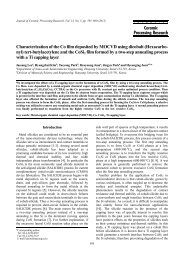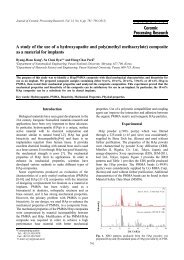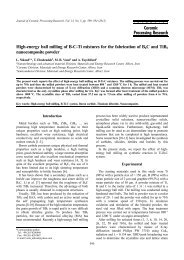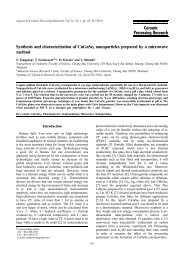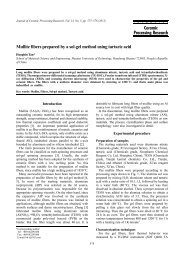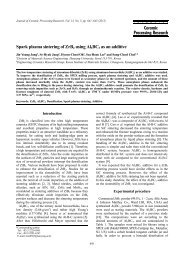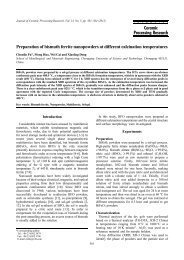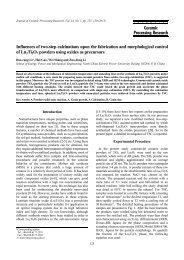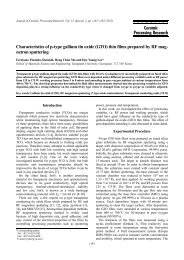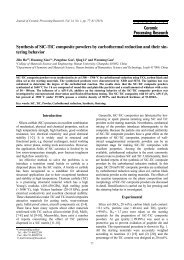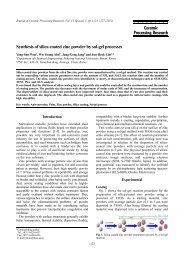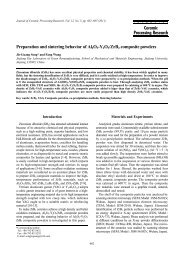Black ceramic pigments for porcelain tile bodies produced with ...
Black ceramic pigments for porcelain tile bodies produced with ...
Black ceramic pigments for porcelain tile bodies produced with ...
Create successful ePaper yourself
Turn your PDF publications into a flip-book with our unique Google optimized e-Paper software.
<strong>ceramic</strong> <strong>pigments</strong> <strong>for</strong> <strong>porcelain</strong> <strong>tile</strong> <strong>bodies</strong> <strong>produced</strong> <strong>with</strong> chromite ores and<br />
<strong>Black</strong><br />
oxide waste<br />
iron<br />
b Anadolu University, Department of Material Science and Engineering, Iki Eylül Campus 26550, Eskisehir, Turkey<br />
this study, two different natural chromite ores and iron oxide waste from the steel rolling industry were used as less expensive<br />
In<br />
raw materials <strong>for</strong> the synthesis of black <strong>ceramic</strong> <strong>pigments</strong> to be used in <strong>porcelain</strong> <strong>tile</strong> <strong>bodies</strong>. The effects of chromite<br />
alternative<br />
oxide waste ratios and calcination temperature on the pigment properties were investigated. It was found that<br />
ore-iron<br />
ore <strong>with</strong> a higher Cr 2 O 3 /FeO ratio can be used to synthesise black <strong>ceramic</strong> <strong>pigments</strong> when combined <strong>with</strong> the iron<br />
chromite<br />
waste. However, their color intensity was not as strong as commercial black <strong>pigments</strong> due to the presence of other phases<br />
oxide<br />
impurities coming from the chromite ores. When these <strong>pigments</strong> were used in combination <strong>with</strong> commercial black <strong>pigments</strong>,<br />
and<br />
natural and synthetic <strong>pigments</strong> find applications<br />
Inorganic<br />
coloring agents in glazes, <strong>ceramic</strong> <strong>bodies</strong> and <strong>porcelain</strong><br />
as<br />
[1]. Most of the synthetic <strong>pigments</strong> are prepared<br />
enamels<br />
metallic oxides or salts of the desired metals and<br />
<strong>with</strong><br />
must be of industrial chemical purity. However, this<br />
they<br />
them rather expensive. There<strong>for</strong>e, current trends are<br />
makes<br />
the use of less expensive natural raw materials<br />
towards<br />
and/or industrial wastes [6-9].<br />
[2-5]<br />
containing structures have been widely studied<br />
Chromium<br />
<strong>ceramic</strong> <strong>pigments</strong> [10, 11] <strong>for</strong> coloring glazes and <strong>ceramic</strong><br />
as<br />
due to their interesting properties including high<br />
<strong>bodies</strong><br />
resistance and chemical stability combined<br />
temperature<br />
suitable optical properties. Chromium-containing black<br />
<strong>with</strong><br />
<strong>pigments</strong> are either in the spinel or hematite<br />
<strong>ceramic</strong><br />
<strong>Black</strong> <strong>pigments</strong> based on the spinel system are<br />
structures.<br />
used to decorate glazed wall and floor <strong>tile</strong>s, since<br />
widely<br />
remain stable when mixed <strong>with</strong> glazes during high<br />
they<br />
firing. Spinel-based black <strong>pigments</strong> are based on<br />
temperature<br />
ferrochromite, (Fe,Co)(Fe,Cr) 2<br />
O 4<br />
or nickel ferrochromite,<br />
cobalt<br />
(Ni,Fe)(Fe,Cr) 2<br />
O 4<br />
compounds. <strong>Black</strong> <strong>pigments</strong> based<br />
the hematite system are synthesised by a traditional<br />
on<br />
state reaction method to obtain a (Fe,Cr) 2<br />
O 3<br />
solid<br />
solid<br />
and are mainly used in coloring <strong>porcelain</strong>-stoneware<br />
solution<br />
<strong>bodies</strong>. They are not suitable <strong>for</strong> glazes due to their<br />
<strong>tile</strong><br />
[12-14].<br />
instability<br />
many minerals contain chromium, chromite is<br />
Although<br />
author:<br />
*Corresponding<br />
: +90-222-2393750<br />
Tel<br />
+90-222-2393613<br />
Fax:<br />
btanisan@ogu.edu.tr<br />
E-mail:<br />
has a spinel crystalline structure and the theoretical<br />
ore<br />
composition is FeCr 2<br />
O 4<br />
(or FeO·Cr 2<br />
O 3<br />
as oxides).<br />
chemical<br />
the composition of chromite ores<br />
However, 2+ chemical<br />
be more generally written as (Mg,Fe )O·<br />
also could<br />
3+ 2 3<br />
owing to the partial natural substitution<br />
(Cr,Al,Fe 2+ ) 2+ 3+ O +3 , +3 , and Cr by Fe and Al in a lower<br />
Mg by Fe of<br />
[15, 16].<br />
proportion<br />
far as <strong>ceramic</strong> <strong>pigments</strong> are concerned, chromite is a<br />
As<br />
inexpensive natural pigment or a raw material<br />
potential<br />
of its high thermal and chemical stability among<br />
because<br />
oxides and is available on the market in a large<br />
natural<br />
[2]. Natural chromite has been used as a pigment<br />
amount<br />
coloring <strong>porcelain</strong> <strong>tile</strong>s, producing dark gray shades<br />
<strong>for</strong><br />
the fired <strong>tile</strong>. A mixture of 95 wt.% chromite and 5 wt.%<br />
on<br />
additions to a body at a certain amount was used to<br />
CoO<br />
black shades on the fired <strong>tile</strong> [17]. It is also reported<br />
get<br />
natural chromite combined <strong>with</strong> commercial black<br />
that<br />
reduced the cost of black coloring <strong>porcelain</strong>-<br />
pigment<br />
<strong>tile</strong>s [4]. However, chromite used in these studies<br />
stoneware<br />
neither calcined nor combined <strong>with</strong> hematite. Recent<br />
was<br />
on producing less expensive Fe-Cr <strong>pigments</strong><br />
investigations<br />
natural raw materials have shown that limonite and<br />
<strong>with</strong><br />
ores could be used to obtain brown <strong>pigments</strong><br />
chromite<br />
transparent and opaque glazes <strong>for</strong> wall <strong>tile</strong>s [2, 14].<br />
<strong>for</strong><br />
from dark brown to light brown, depending on the<br />
Colors<br />
temperature and chromite-limonite content,<br />
calcination<br />
obtained and present a good alternative to commercial<br />
were<br />
<strong>produced</strong> from pure oxides.<br />
<strong>pigments</strong><br />
oxides are the most widely used raw materials <strong>for</strong><br />
Iron<br />
production. The continually increasing importance<br />
pigment<br />
iron oxide-based <strong>pigments</strong> is due to their non-toxicity,<br />
of<br />
stability, wide variety of colors ranging from<br />
chemical<br />
orange, red, brown to black and low price [18].<br />
yellow,<br />
is reported that hundreds and thousands of tons of<br />
It<br />
J O U R N A L O F<br />
Journal of Ceramic Processing Research. Vol. 12, No. 4, pp. 462~467 (2011)<br />
Ceramic<br />
Processing Research<br />
Tanisan a, * and Servet Turan b<br />
a Belgin<br />
Osmangazi University, Department of Metallurgical and Materials Engineering, Meselik Campus 26480, Eskisehir, Turkey<br />
Eskisehir<br />
the consumption of the commercial <strong>pigments</strong> can be reduced, providing cost savings <strong>for</strong> coloration of <strong>porcelain</strong> <strong>tile</strong> <strong>bodies</strong>.<br />
Key words: <strong>Black</strong> <strong>ceramic</strong> pigment, Chromite, Iron oxide waste, Spinel, Color.<br />
Introduction<br />
the only commercial ore mineral of chromium. Pure chromite<br />
462
unusable solid waste containing from less<br />
practically<br />
15 to more than 90% iron are <strong>for</strong>med annually by<br />
than<br />
chemical, mechanical engineering and other<br />
metallurgical,<br />
plants [19]. There are several studies on the<br />
industrial<br />
of iron-chromium brown and/or black <strong>ceramic</strong><br />
synthesis<br />
<strong>for</strong> glazes and <strong>porcelain</strong> <strong>tile</strong> <strong>bodies</strong> from Fe-rich<br />
<strong>pigments</strong><br />
wastes. For example, cast iron foundry grinding<br />
industrial<br />
together <strong>with</strong> chromite [20], copper slag flotation<br />
waste<br />
<strong>with</strong> chromite, Cr 2 O 3 , ZnO and CoO [21], Fe-rich<br />
waste<br />
sludge generated during steel wiredrawing<br />
galvanizing<br />
Cr/Ni-rich sludge [22, 23] generated from Cr/Ni<br />
<strong>with</strong><br />
have been used.<br />
plating<br />
aim of this study is to produce (Fe,Cr) 2 O 3 black<br />
The<br />
<strong>pigments</strong> by using natural chromite ores and iron<br />
<strong>ceramic</strong><br />
waste from the steel rolling industry and to investigate<br />
oxide<br />
suitability <strong>for</strong> coloring <strong>porcelain</strong> <strong>tile</strong> <strong>bodies</strong> as a way<br />
their<br />
reduce their coloring cost. It is to be noted that (Fe,Cr) 2 O 3<br />
to<br />
<strong>ceramic</strong> pigment is the most extensively used pigment<br />
black<br />
materials<br />
Raw<br />
ores <strong>with</strong> different chemical compositions;<br />
Chromite<br />
chromite I (Kumas A.S., Turkey) and chromite II<br />
namely<br />
Chimica Mineraria S.P.A, Italy) and iron oxide<br />
(Laviosa<br />
and characterisation of <strong>pigments</strong><br />
Preparation<br />
chromite ores and iron oxide waste was<br />
As-received<br />
separately to the required particle-size by planetary<br />
ground<br />
ball-milling using distilled water and dried. Then,<br />
wet<br />
ores and iron oxide waste containing 30-100 wt.%<br />
chromite<br />
I ore and chromite II ore were mixed by wet<br />
chromite<br />
<strong>for</strong> 20 minutes and the slurries were dried<br />
ball-milling<br />
110 o C. This was followed by calcination firstly at 1200 o C<br />
at<br />
5 hours dwell time. This temperature was selected<br />
<strong>for</strong><br />
the previous studies on a similar system [24]. In<br />
from<br />
to see the effect of the calcination temperature on<br />
order<br />
products, a selected composition was also calcined<br />
reaction<br />
1100 o C and 1300 o C using the same dwell time. The<br />
at<br />
<strong>pigments</strong> were ground by planetary wet ball-<br />
calcined<br />
<strong>for</strong> 2 hours, filtered and dried at 110 o C in an oven.<br />
milling<br />
order to evaluate the color development, 3 wt.% ground<br />
In<br />
was added to a <strong>porcelain</strong> <strong>tile</strong> body composition,<br />
pigment<br />
from a <strong>ceramic</strong> factory (Toprak A.S, Eskisehir,<br />
supplied<br />
Table 1. Chemical composition of raw materials obtained by using XRF analysis (wt.%)<br />
was pressed into 4 cm diameter pellets at 40 MPa<br />
mix<br />
fired in an electric furnace at 1190 o C in 45 minutes<br />
and<br />
cold to cold.<br />
from<br />
compositions of the raw materials were determined<br />
The<br />
an X-ray fluorescence spectrometer (XRF, RIGAKU<br />
using<br />
Primus). A laser diffraction particle size analyser<br />
ZSX<br />
MASTERSIZER 2000G) was used to find<br />
(MALVERN<br />
the particle size distribution of the raw materials and<br />
out<br />
The crystalline phases in the samples were<br />
<strong>pigments</strong>.<br />
using an X-ray diffractometer (XRD, RIGAKU<br />
identified<br />
2200-Series). In the XRD analysis, metallic silicon<br />
Rint<br />
powder was used as a reference to determine the exact<br />
(Si)<br />
of the phases present and also to compare their<br />
d-spacings<br />
amounts.<br />
relative<br />
color parameters of fired <strong>porcelain</strong> <strong>tile</strong> samples<br />
L*a*b*<br />
<strong>with</strong> the <strong>pigments</strong> <strong>produced</strong> in this study were<br />
colored<br />
<strong>with</strong> an UV-Vis spectrophotometer (MINOLTA<br />
measured<br />
d). Measurements were recorded <strong>with</strong> a small<br />
3600<br />
and a standard D 65 light source. The color<br />
aperture<br />
L*, a* and b*, were measured according to<br />
coordinates,<br />
CIE-L*a*b* trichromatic system recommended by the<br />
the<br />
(Commission Internationale del’Eclairage) [25]. In<br />
CIE<br />
system, L* is the degree of lightness and darkness<br />
this<br />
the color in relation to the scale extending from white<br />
of<br />
= 100) to black (L* = 0). a* is the scale extending<br />
(L*<br />
green (−a*) to red (+a*) axis and b* is the scale<br />
from<br />
from blue (−b*) to yellow (+b*) axis. The<br />
extending<br />
difference (∆E*) was calculated according to<br />
color<br />
[(∆L*) 2 +(∆a*) 2 +(∆b*) 2 ] 1/2 . The values ∆L*, ∆a*<br />
∆E*=<br />
∆b* correspond to the difference of each parameter<br />
and<br />
of raw materials<br />
Characterisation<br />
compositions of the raw materials determined<br />
Chemical<br />
the XRF technique are given in Table 1. When<br />
using<br />
I and chromite II ores were compared, they both<br />
chromite<br />
similar amounts of Cr 2 O 3 , chromite I was<br />
contained<br />
to contain less FeO and consequently the Cr 2 O 3 /FeO<br />
found<br />
was higher <strong>for</strong> chromite I. There were also differences<br />
ratio<br />
MgO, Al 2 O 3 and SiO 2 contents in that chromite I was<br />
in<br />
in MgO and SiO 2 whereas chromite II was rich in<br />
rich<br />
2 O 3. The iron oxide waste was determined to contain<br />
Al<br />
97 wt.% Fe 2 O 3 (Table 1). XRD analysis showed that<br />
over<br />
iron oxide waste contained only the hematite phase<br />
the<br />
1(a)) and thus the iron oxide waste will be named<br />
(Fig.<br />
the “hematite waste” hereafter. XRD analysis also showed<br />
as<br />
<strong>Black</strong> <strong>ceramic</strong> <strong>pigments</strong> <strong>for</strong> <strong>porcelain</strong> <strong>tile</strong> <strong>bodies</strong> <strong>produced</strong> <strong>with</strong> chromite ores and iron oxide waste 463<br />
in <strong>porcelain</strong> <strong>tile</strong> production.<br />
Experimental<br />
waste from the steel rolling industry (Eregli Demir-Celik<br />
I<br />
Fabrikalar T.A.S., Turkey) were used as raw materials.<br />
recorded <strong>for</strong> the two samples that are being compared.<br />
Results and Discussion<br />
Turkey) by wet ball-milling. The dried <strong>porcelain</strong> powder<br />
Raw materials Fe 2 O 3 Cr 2 O 3 Al 2 O 3 SiO 2 FeO MgO CaO Others LOI<br />
Iron oxide waste 97.5 0.8 0.9 0.4 0.5<br />
Chromite I ore 42.5 8.4 7.4 17.7 17.8 1.8 1.0 3.4<br />
Chromite II ore 40.9 13.4 3.4 31.1 8.9 1.3 0.9<br />
(LOI is loss of ignition at 1000 o C)
oth chromites contained only spinel type phases<br />
that<br />
that chromite I also contained a minor amount<br />
except<br />
quartz (Fig. 1(b)). It is rather difficult to differentiate<br />
of<br />
composition spinel phases in chromites. However,<br />
different<br />
et al. [26] demonstrated that the iron present<br />
Sanchez-Ramos<br />
the spinel phase of chromite had a +2 valency and thus<br />
in<br />
the phase as the generic magnesiochromite<br />
identified 2+ spinel<br />
)(Cr,Al) 2<br />
O 4<br />
]. For this reason, the content<br />
[(Mg,Fe ferroan<br />
iron oxide is given as FeO in Table 1.<br />
of<br />
2 gives the particle-size distribution of each raw<br />
Table<br />
after planetary ball milling. The average particlesize<br />
material<br />
was around 7 µm and 90% of the particles are below<br />
25 µm. It is known that solid state reactions between<br />
about<br />
components primarily depend on the particle size: the<br />
two<br />
the particle size, the easier is the reaction between the<br />
finer<br />
However, milling into lower particle sizes by<br />
components.<br />
milling requires prolonged milling time that increases<br />
ball<br />
cost of processing.<br />
the<br />
of <strong>pigments</strong><br />
Characterisation<br />
XRD patterns of <strong>pigments</strong> <strong>produced</strong> <strong>with</strong> the use<br />
The<br />
different of chromite I and hematite waste<br />
of o amounts<br />
at 1200 C are shown in Fig. 2. When<br />
calcined mixtures<br />
I was calcined alone, the occurrence of a free<br />
chromite<br />
2<br />
O 3<br />
phase was evident together <strong>with</strong> predominant spinel<br />
Cr<br />
The free Cr 2<br />
O 3<br />
phase was not seen in the XRD<br />
phases.<br />
of the as-received raw material (Fig. 1(b)). This<br />
pattern<br />
Raw materials d 10 d 50 d 90<br />
patterns of <strong>pigments</strong> <strong>produced</strong> by calcining different<br />
XRD<br />
of chromite I-hematite waste mixtures at a constant<br />
amounts<br />
2+ the chromium-containing spinel [(Mg,Fe )·<br />
reveals that<br />
O 4<br />
] was separating to Cr 2<br />
O 3<br />
and another type<br />
2<br />
(Cr,Al)<br />
spinel at high temperatures. This phenomenon was also<br />
of<br />
by Sanchez-Ramos et al. [26] who demonstrated<br />
observed<br />
the Cr 2<br />
O 3<br />
segregates as a differentiable compound,<br />
that<br />
removed from the chromite spinel and remaining<br />
being<br />
in as magnesium, aluminium and iron oxides<br />
only o spinels<br />
C. In the compositions containing hematite<br />
800 above<br />
in addition to the presence of the spinel phases, the<br />
waste,<br />
free Cr 2<br />
O 3<br />
reacts <strong>with</strong> the hematite (Fe 2<br />
O 3<br />
) to<br />
generated<br />
a solid solution phase (Fe 1-x<br />
Cr x<br />
) 2<br />
O 3<br />
(Fig. 2). In the<br />
produce<br />
diagram of Fe 2<br />
O 3<br />
and Cr 2<br />
O 3<br />
, these oxides can be<br />
phase<br />
to a complete (Fe,Cr) 2<br />
O 3<br />
solid solution<br />
observed o generate<br />
the range of compositions up to 1400 C [27]. As<br />
all <strong>for</strong><br />
same amount of silicon (Si) was used in the samples<br />
the<br />
an internal standard, the intensity ratio of the solid<br />
as<br />
phase (Fe 1−xCr x<br />
) 2<br />
O 3<br />
(F) and Si (F/Si) can be used<br />
solution<br />
follow the development of the solid solution phase.<br />
to<br />
Fig. 2, F 110<br />
/Si 111<br />
ratio is 0.0, 0.48, 0.75 and 1.16 <strong>for</strong> the<br />
In<br />
of 100% chromite I, 80% chromite I-20% hematite<br />
mixtures<br />
60% chromite I-40% hematite waste and 40%<br />
waste,<br />
I-60% hematite waste, respectively. The highest<br />
chromite<br />
is observed in the 40% chromite I-60% hematite waste<br />
ratio<br />
indicating that this sample contains the largest<br />
sample,<br />
of the solid solution phase.<br />
amount<br />
XRD patterns of <strong>pigments</strong> <strong>produced</strong> <strong>with</strong> the use<br />
The<br />
different of chromite II and hematite waste<br />
of o amounts<br />
at 1200 C are presented in Fig. 3. The<br />
calcined mixtures<br />
phases were spinels and the solid solution phase<br />
main<br />
1−xCr<br />
x<br />
) 2<br />
O 3<br />
in all compositions. No free Cr 2<br />
O 3<br />
phase<br />
(Fe<br />
464 Belgin Tanisan and Servet Turan<br />
Table 2. Particle size distribution of ball milled raw materials (µm)<br />
Iron oxide waste 1.1 7.8 24.9<br />
Chromite I ore 0.9 7.1 23.0<br />
Chromite II ore 1.0 6.7 20.2<br />
Fig. 2.<br />
temperature of 1200 o C (CI : chromite I, H : hematite waste).<br />
Fig. 1.<br />
XRD patterns of iron oxide waste (a) and chromite ores (b).
3. XRD patterns of <strong>pigments</strong> <strong>produced</strong> by calcining different<br />
Fig.<br />
of chromite II-hematite waste mixtures at a constant<br />
amounts<br />
was observed in the pure chromite II after<br />
<strong>for</strong>mation<br />
in contrast to pure chromite I. This may be due<br />
calcination<br />
the higher amount of FeO content of chromite II which<br />
to<br />
the solid solution phase directly upon calcination.<br />
<strong>for</strong>ms<br />
the F 110 /Si 111 ratio (~0.8) was not changed substantially<br />
Although<br />
<strong>with</strong> the addition of hematite waste, the solid solution<br />
became rich in iron (see the shift of the solid solution<br />
phase<br />
to lower 2θ values, indicated by a dotted line in<br />
peaks<br />
3). Similar shift of 2θ values of the solid solution phase<br />
Fig.<br />
Fe 2 O 3 was also observed by Munoz et al. [24].<br />
<strong>with</strong><br />
both chromite I and chromite II containing compositions,<br />
In<br />
the highest amount of solid solution phase was<br />
when 40% chromite I and 60% hematite waste<br />
obtained<br />
used. There<strong>for</strong>e, to see the effect of temperature on<br />
were<br />
solid solution phase <strong>for</strong>mation, this composition was<br />
the<br />
constant and also calcined at 1100 o C and 1300 o C.<br />
kept<br />
XRD patterns of <strong>pigments</strong> <strong>produced</strong> from 40%<br />
The<br />
I and 60% hematite waste mixtures calcined<br />
chromite<br />
between 1100 o C and 1300 o C are compared in Fig. 4.<br />
at<br />
the same figure, a diffraction pattern of the commercial<br />
In<br />
pigment (Coded as CP-2) is also shown <strong>for</strong> comparison.<br />
black<br />
The XRD results showed that the samples calcined<br />
all temperatures contained (Fe 1−x Cr x ) 2 O 3 solid solution<br />
at<br />
spinel phases. The F 110 /Si 111 intensity ratios in Fig. 4<br />
and<br />
0.58, 1.16 and 0.86 at 1100 o C, 1200 o C and 1300 o C,<br />
is<br />
This indicates that the highest amount of<br />
respectively.<br />
solid solution phase was obtained at 1200 o C which was<br />
the<br />
at the beginning of the study to find out the<br />
selected<br />
composition <strong>for</strong> the <strong>for</strong>mation of the highest<br />
optimum<br />
of the solid solution phase. While the lower amount<br />
amount<br />
the solid solution phase at 1100 o C may be due to<br />
of<br />
reactions, its decreased amount at 1300 o C may<br />
incomplete<br />
due to the decomposition of the solid solution phase<br />
be<br />
by an increased vapour pressure of Cr 2 O 3 .<br />
possibly<br />
measurement<br />
Color<br />
measured L*a*b* values of colored <strong>porcelain</strong> <strong>tile</strong>s<br />
The<br />
4. XRD patterns of <strong>pigments</strong> containing 40% chromite I-<br />
Fig.<br />
hematite waste mixture calcined at different temperatures<br />
60%<br />
1100 o C and 1300 o C. An XRD pattern of black commercial<br />
between<br />
(CP-2) is also included <strong>for</strong> comparison purposes.<br />
pigment<br />
3 wt.% <strong>pigments</strong> (<strong>produced</strong> at 1200 o C according<br />
containing<br />
the procedure given above) are shown in Fig. 5. The<br />
to<br />
prepared <strong>with</strong> pure chromite I gives a yellowbrown<br />
pigment<br />
color which has L*a*b* values of 41.6, 3.0 and 5.2.<br />
an increasing hematite waste percentage in chromite<br />
With<br />
waste mixtures, L*a*b* values were all decreased<br />
I-hematite<br />
the lowest L*a*b* values of 35.9, 1.4 and 1.1, which<br />
and<br />
better black coloring, were obtained <strong>with</strong> the use<br />
indicate<br />
the 40% chromite I and 60% hematite waste composition.<br />
of<br />
These results are in line <strong>with</strong> the XRD spectra that<br />
use of 40% chromite I and 60% hematite waste gave<br />
the<br />
largest amount of the (Fe 1−x Cr x ) 2 O 3 solid solution phase<br />
the<br />
a concurrent decrease of the spinel phase intensity.<br />
<strong>with</strong><br />
commercial black <strong>pigments</strong>, coded as CP-1<br />
However,<br />
CP-2 (Itaca, Spain) both gave L*, a* and b* values of<br />
and<br />
33, < 1 and < 0.5, respectively (Table 3). This indicates<br />
<<br />
even the lowest L*a*b* giving composition (40%<br />
that<br />
I-60% hematite waste) is not good enough to be<br />
chromite<br />
as a replacement <strong>for</strong> a commercial black pigment.<br />
used<br />
may be attributed to the dilution effect of impurity<br />
This<br />
The other reason might be the difference in the<br />
oxides.<br />
size distribution of the pigment. However, please<br />
particle<br />
note that the particle size distribution of the synthesised<br />
also<br />
used in this study was very similar to the com-<br />
pigment<br />
black <strong>pigments</strong> (Table 4). In order to increase the<br />
mercial<br />
coloring, that is, to decrease L*a*b* values, 0.5 and<br />
black<br />
wt.% of a commercial black pigment (CP-2) was used<br />
1<br />
<strong>with</strong> 3 wt.% the pigment (40% chromite I-60%<br />
together<br />
waste composition) in a <strong>porcelain</strong> <strong>tile</strong> body.<br />
hematite<br />
was selected as the commercial black pigment to<br />
CP-2<br />
used together <strong>with</strong> the synthesised pigment in this<br />
be<br />
due to its better L*a*b* values (Table 3). The addition<br />
study<br />
the commercial pigment reduced the L*a*b* values as<br />
of<br />
in Table 3, approaching those of the pure commercial<br />
given<br />
This indicates that chromite I and hematite waste<br />
pigment.<br />
can be a cost-effective complementary to the<br />
mixtures<br />
<strong>Black</strong> <strong>ceramic</strong> <strong>pigments</strong> <strong>for</strong> <strong>porcelain</strong> <strong>tile</strong> <strong>bodies</strong> <strong>produced</strong> <strong>with</strong> chromite ores and iron oxide waste 465<br />
temperature of 1200 o C (CII : chromite II, H : hematite waste).<br />
commercial black <strong>pigments</strong> and help to reduce their usage.
5. The L*a*b* values of colored and fired <strong>porcelain</strong> <strong>tile</strong><br />
Fig.<br />
containing 3 wt.% pigment, prepared by calcining different<br />
samples<br />
of chromite I-hematite waste and chromite II-hematite<br />
amounts<br />
mixtures at a constant temperature of 1200 o C.<br />
waste<br />
3. CIE-L*a*b* and calculated DE* values of colored<br />
Table<br />
<strong>tile</strong> samples<br />
<strong>porcelain</strong><br />
Reference<br />
pigment<br />
Pigment<br />
(wt.%)<br />
CP-2<br />
(wt.%)<br />
a* b* DE*(1) DE*<br />
L*<br />
(2)<br />
and CP-2 : commercial black <strong>pigments</strong>, 40CI-60H designates<br />
(CP-1<br />
chromite I and 60% of hematite waste derived pigment)<br />
40%<br />
Pigment d 10 d 50 d 90<br />
and CP-2 : commercial black <strong>pigments</strong>, 40CI-60H designates<br />
(CP-1<br />
chromite I and 60% of hematite waste derived pigment)<br />
40%<br />
measured L*a*b* values of <strong>pigments</strong> containing<br />
The<br />
chromite I and 60% hematite waste calcined at<br />
40%<br />
between 1100 o C and 1300 o C are given in<br />
temperatures<br />
6. The L*a*b* values of <strong>pigments</strong> were influenced by<br />
Fig.<br />
calcination temperature. L* values decrease <strong>with</strong> a<br />
the<br />
calcination temperature, whereas the values<br />
decreasing<br />
a* and b* were considerably lower at a calcination<br />
of<br />
of 1200 o C in comparison to 1100 o C and<br />
temperature<br />
o C. These coloring observations are in line <strong>with</strong> XRD<br />
1300<br />
given in Fig. 4.<br />
data<br />
prepared <strong>with</strong> chromite II resulted in darker<br />
Pigments<br />
than those <strong>with</strong> chromite I where the chromite<br />
colors<br />
was higher (> 80%) (Fig. 5). This is due to the<br />
content<br />
of the solid solution phase even in the pure<br />
<strong>for</strong>mation<br />
II containing sample. However, at lower chromite<br />
chromite<br />
L*a*b* values of chromite II derived <strong>pigments</strong><br />
contents,<br />
not as low as chromite I derived <strong>pigments</strong>. The<br />
were<br />
black coloring of chromite I and hematite waste<br />
better<br />
6. The L*a*b* values of colored <strong>porcelain</strong> <strong>tile</strong> samples<br />
Fig.<br />
3 wt.% pigment, synthesised by calcining a 40%<br />
containing<br />
I-60% hematite waste mixture at temperatures between<br />
chromite o C and 1300 o C.<br />
1100<br />
466 Belgin Tanisan and Servet Turan<br />
CP-1 3 - 33.0 1.0 0.4 - 1.9<br />
CP-2 3 - 31.4 0.3 -0.3 1.9 -<br />
40CI-60H 3 - 35.9 1.4 1.1 3.0 4.8<br />
40CI-60H 3 0.5 34.5 1.4 0.9 1.6 3.5<br />
40CI-60H 3 1.0 33.8 1.0 0.2 0.8 2.5<br />
4. Particle size distribution of <strong>pigments</strong> (µm)<br />
Table<br />
CP-1 2.4 6.0 14.6<br />
CP-2 1.5 4.7 10.4<br />
40CI-60H 1.9 5.6 12.8
evidenced by lower L* and a* values, may be<br />
mixtures,<br />
to somewhat higher solid solution phase <strong>for</strong>mation in<br />
due<br />
I and hematite waste mixtures. This may be due<br />
chromite<br />
the exsolution of Cr 2 O 3 from chromite I, readily reacting<br />
to<br />
using less expensive chromite ores and hematite<br />
By<br />
black <strong>ceramic</strong> <strong>pigments</strong> suitable <strong>for</strong> <strong>porcelain</strong> <strong>tile</strong><br />
waste,<br />
coloring can be <strong>produced</strong>. A black color close to<br />
body<br />
black <strong>pigments</strong> was obtained after calcination<br />
commercial<br />
40% chromite I and 60% hematite waste mixture at<br />
of o C. The black coloring phase is the (Fe 1−x Cr x ) 2 O 3 solid<br />
1200<br />
phase. However, due to the presence of impurity<br />
solution<br />
of Al 2 O 3 , SiO 2 and MgO the color intensity is not<br />
oxides<br />
strong as commercial black <strong>pigments</strong> which are generally<br />
as<br />
<strong>with</strong> higher purity oxides. These <strong>pigments</strong>, when<br />
prepared<br />
<strong>with</strong> a small amount of commercial black<br />
combined<br />
can reduce the consumption of the more expensive<br />
<strong>pigments</strong>,<br />
<strong>pigments</strong>, providing cost savings <strong>for</strong> black<br />
commercial<br />
of <strong>porcelain</strong> <strong>tile</strong> <strong>bodies</strong>.<br />
coloration<br />
would like to thank Eregli Demir-Celik Fabrikalari<br />
We<br />
Kumas A.S. and Laviosa Chimica Mineraria S.P.A<br />
T.A.S,<br />
the supply of raw materials. One of us (B. Tanisan)<br />
<strong>for</strong><br />
likes to thank Anadolu University, Material Science<br />
also<br />
Engineering Dept. <strong>for</strong> the use of their facilities and<br />
and<br />
Pervin Dag <strong>for</strong> her help.<br />
Miss<br />
T. Manfredini and F. Bondioli, Ceramic Ind. 150[2] (2000)<br />
1.<br />
53-58.<br />
E. Ozel, I. Küçük and S. Turan, Silicates Ind. 68 (2003) 25-28.<br />
2.<br />
A.B. Corradi, C. Leonelli, T. Manfredini, P. Pozzi and M.<br />
3.<br />
American Ceram. Soc. Bull. 72[5] (1993) 63-69.<br />
Romagnoli,<br />
F. Bondioli, A.M. Ferrari, C. Leonelli and T. Manfredini,<br />
4.<br />
Eng. Proc. 18[2] (1997) 44-58.<br />
Ceram.<br />
V.M. Pogrebenkov and M.B. Sedel’nikova, Glass and<br />
5.<br />
59(2002) 396-399.<br />
Ceramics.<br />
G. Costa, M.J. Ribeiro, T. Trindate and J.A. Labrincha, Bol.<br />
6.<br />
(1994) 63-69.<br />
73[12]<br />
F.J. Berry, N. Costantini and L.E. Smart, Waste Manage.<br />
8.<br />
(2002) 761-772.<br />
22<br />
R.I. Lazau, C. Pacurariu, D. Becherescu and R. Ianos, J.<br />
9.<br />
Ceram. Soc. 27 (2007) 1899-1903.<br />
Eur.<br />
T.S. Lyubenova, M. Ocana and J. Carda, Dyes and Pigments.<br />
10.<br />
(2008) 265-269.<br />
79<br />
R. Munoz, N. Maso, B. Julian, F. Marquez, H. Beltran, P.<br />
11.<br />
and E. Cordoncillo, J. Eur. Ceram. Soc. 24[7]<br />
Escribano<br />
2087-2094.<br />
(2004)<br />
J. Calbo, M.A. Tena, G. Monros, M. Llusar, R. Galindo and<br />
12.<br />
Badenes, American Ceram. Soc. Bull. 84[12] (2005)<br />
J.A.<br />
10-14.<br />
J. Calbo, S. Sorli, M. Llusar, M.A. Tena and G. Monros,<br />
13.<br />
Ceram. Trans. 103[1] (2004) 3-9.<br />
Brith.<br />
E. Ozel and S. Turan, J. Eur. Ceram. Soc. 23 (2003) 2097-2104.<br />
14.<br />
H.B. Xu, Y. Zhang, Z.H. Li, S.L. Zheng, Z.K. Wang, T. Qi<br />
15.<br />
H.Q. Li, J. Cleaner Production. 14 (2006) 211-219.<br />
and<br />
M.F. Gazulla, A. Barba, M.P. Gomez and M. Orduna,<br />
16.<br />
and Geoanalytical Research. 30[3] (2006)<br />
Geostandards<br />
237-243.<br />
G. Biffi, “Porcelain Stoneware Production Manual Method<br />
17.<br />
Use” (Gruppo Editoriale Faenza Editrice S.p.A. Italy, 1999).<br />
of<br />
O.K.R. Montedo, F.M. Bertan, R. Picolli, D. Hotza and A.P.<br />
18.<br />
de Oliveria, Qualicer. (2004) 11-13.<br />
Novaes<br />
A.N. Epikhin and A.V. Krylova, Russian Journal of Applied<br />
19.<br />
76[1] (2003) 20-22.<br />
Chem.<br />
S. Turan, Y. Inceefe and E. Ozel, Key Eng. Mater. 264-268<br />
20.<br />
2473-2476.<br />
(2004)<br />
E. Ozel, S. Turan, S. Çoruh and O.N. Ergun, Waste Manage.<br />
21.<br />
24 (2006) 125-133.<br />
Res.<br />
G. Costa, V.P. Della, M.J. Ribeiro and J.A. Labrincha, American<br />
22.<br />
Soc. Bull. 87[7] (2008) 9101-9107.<br />
Ceram.<br />
G. Costa, V.P. Della, M.J. Ribeiro, A.P.N. Oliveria, G. Monros<br />
23.<br />
J.A. Labrincha, Dyes and Pigments. 77 (2008) 137-144.<br />
and<br />
R. Munoz, M. Martos, C.M. Rotaru, H. Beltran, E. Cordoncillo<br />
24.<br />
P. Escribano, J. Eur. Ceram. Soc. 26[8] (2006) 1363-1370.<br />
and<br />
C.I.E (1978) Recommendations on uni<strong>for</strong>m color spaces,<br />
25.<br />
difference equations, psychometric color terms.<br />
color<br />
No.2 to CIE publication No.15 1971.<br />
Supplement<br />
S. Sanchez-Ramos, A. Domenech-Carbo, J.V. Gimeno-<br />
26.<br />
J. Peris-Vicente and F.M. Valle-Algarra,<br />
AdelantadoÅ,<br />
Acta. 476 (2008) 11-19.<br />
Thermochimica<br />
A. Muan and S. Somiya, J. Am. Ceram. Soc. 57 (1960)<br />
27.<br />
<strong>Black</strong> <strong>ceramic</strong> <strong>pigments</strong> <strong>for</strong> <strong>porcelain</strong> <strong>tile</strong> <strong>bodies</strong> <strong>produced</strong> <strong>with</strong> chromite ores and iron oxide waste 467<br />
Soc. Esp. Ceram V. 46[1] (2007) 7-13.<br />
7. N. Ay, M. Çak and A. Kara, American Ceram. Soc. Bull.<br />
I<br />
<strong>with</strong> the hematite waste to <strong>for</strong>m the solid solution phase.<br />
Conclusions<br />
Acknowledgements<br />
References<br />
204-209.



